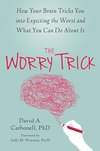The Worry Trick: How Your Brain Tricks You into Expecting the Worst and What You Can Do About It
amazon.com
The Worry Trick: How Your Brain Tricks You into Expecting the Worst and What You Can Do About It

research on the subject of thought suppression2 clearly shows that the main effect of thought suppression is a resurgence of the thoughts
worry is based on ideas of what “would be bad” rather than what is likely.
you experience doubt, and treat it like danger
Serenity Prayer: God, grant me the serenity to accept the things I cannot change, The courage to change the things I can, And the wisdom to know the difference.
in fact the thought is simply an expression of nervousness
Chronic worry doesn’t alert you to problems that need solving. It interferes with problem solving. If you experience chronic worry, your attention is focused on unlikely hypothetical future disasters, rather than current situations that require a solution. Chronic worries don’t get solved because there really isn’t anything to solve. The worry just
... See moredanger, we fight, or run, or freeze. For discomfort, we chill out and give it time to pass.
if you create the habit of humoring your worrisome thoughts, you can increasingly pass over the invitation to argue without becoming embroiled or upset. You can play with the thoughts, rather than work against them.
When are we motivated to distract ourselves from unpleasant and worrisome thoughts? When we’re not facing a clear and present danger.